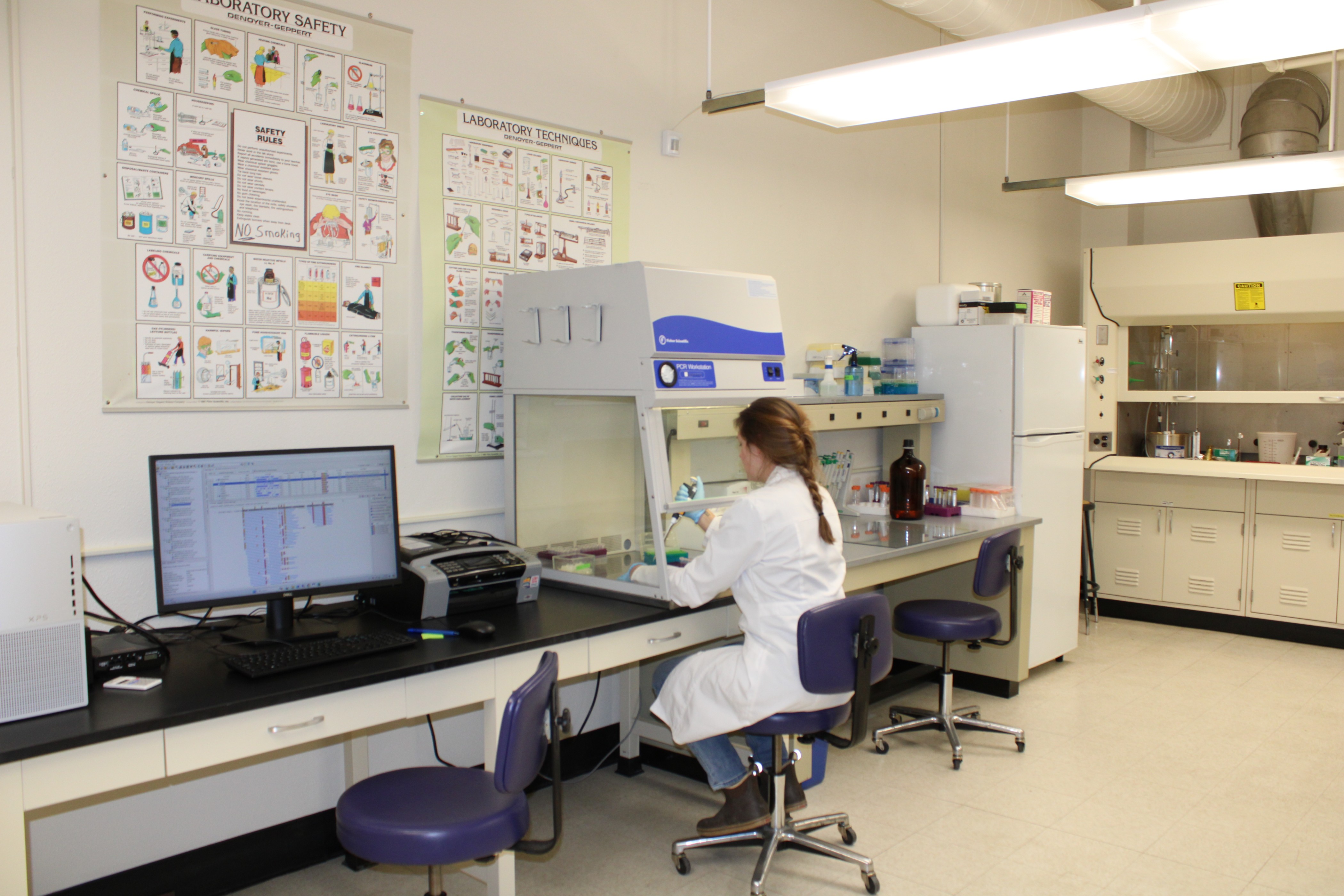Facilities
Anthropology Labs
The Archaeology/GIS Lab is designed to accommodate instruction, student archaeological analysis and GIS research, and laboratory portions of a number of courses (e.g., ANTH-492/692 Archaeology Seminars, ANTH-211 Fundamentals of Archaeology). The space is suitable for examination of archaeological collections, including lithic, faunal, spatial and other analyses.
Three computers with ArcGIS and all extensions, including 3d Analyst and Geospatial Analyst, form the hub of the GIS laboratory. Lithic comparative and analytical collections (including material types and technologies) are available for students to use, as well as low-powered stereoscopes. Two additional computers are dedicated to materials analysis, and all five computers have SPSS statistical software and Surfer 3d mapping software.
For more information contact Ben Potter.
The Environmental Lab hosts a wide range of faculty, staff and student research oriented to reconstructing local environments through time and understanding long-term human ecosystem adaptations. This lab is equipped with instrumentation for the preparation of archaeological specimens (e.g., bones, teeth, soils) for isotope analysis, radiocarbon dating, soil chemistry. Instrumentation includes: freeze dryer, mixer mill, Milli-Q ultra pure water system, fume hood for chemical work, analytical balance and microbalance, multiple sizes of centrifuges, and other support equipment.
For more information contact Josh Reuther.
This lab houses an extensive skeletal comparative collection that is used for teaching and research. The collection focuses mainly on Alaskan fauna with additional specimens from the South Pacific and around the world.
For more information, contact Justin Cramb.
The Forensic Anthropology Lab is equipped to teach forensic anthropological casework and research methods, and to conduct casework and skeletal analyses.
The lab contains equipment for performing skeletal analyses including osteometric boards, spreading and sliding calipers, a mandibulometer, 2 microscribes, ASUDAS plaques, pubic symphysis aging kits, as well as various software for estimating sex, age, stature, and biological affinity.
The lab is also home to human skeletal casts used for casework comparison and teaching, including reproductions representing human variation and pathological exemplars and primate and hominid fossil casts.
Additionally, the department houses the Brian Hemphill Dental Anthropology Collection;
a collection of dental casts from South Asian populations compiled by Dr. Brian
Hemphill.
For more information, contact Petra Banks
The ADAPt Lab contributes to knowledge of ancient diets and pyrotechnologies through the analysis of organic residues in archaeological ceramics and hearth sediments. Organic residues from foods and fuels are analyzed using a combined approach integrating molecular and isotopic data.
The ADAPt Lab also conducts proteomic sex estimation of amelogenin, a sexually dimorphic
protein in tooth enamel. This is a robust method of sex estimation applicable to the
youngest through the oldest members of archaeological populations. https://www.nature.com/articles/s41598-020-68550-w
The lab is capable of analyzing other proteins in a range of dental tissues and in dental calculus, providing a novel source of information on past diets and human health.
Equipment in the lab includes a fume hood, laminar flow cabinet, chemical cabinets,
Leica M80 zoom steromicroscope fitted with an IC80HD digital camera for real-time
images, flex-shaft drill for cutting and preparing samples, analytical balance, thermomixer,
two microcentrifuges and two compact benchtop centrifuges for standard size test tubes,
a -20℃ freezer, and a drying oven. For data analysis, the lab has a PC and laptop
with Mass Hunter software and NIST 7.0 Mass Spectral Library and PEAKS 12 software
for DDA and DIA shotgun proteomics analysis.

For more information contact Tammy Buonasera
This lab is PCR-free and contains two biosafety cabinets for preparation of ancient DNA specimens and ancient DNA extraction.
For more information contact Kara Hoover
The newly renovated and expanded Digital Ethnography Lab in Bunnell 309 provides students with state of the art audiovisual equipment for recording in digital audio and video and computational facilities designed for multimedia editing, acoustic analysis, transcription and discourse analysis and digitizing and archiving analog and minidisc materials.
The lab is equipped with two PowerMac quad core computers, with Adobe Premiere Professional and Final Cut programs for advanced video editing and six new Asus work stations and a new PC laptop installed with GIS software for student check out. All computers have Adobe Premiere Professional and Photoshop for visual analysis and are installed with: Praat, Audacity, Transana, Express-scribe and Elan for transcription and discourse analysis. There are digital foot pedals and studio quality headphones for transcription. We have a high speed audio cassette copier and cassette-to-CD dubbing equipment to facilitate digitizing archival CD recordings. There is a mini-DV deck for copying digital video cassettes. We also have a minidisc deck that allows digitization and copying of minidiscs for archival purposes. The lab also has numerous Marantz and small Tascam digital audio field recorders, cardiod and binaural lapel microphones, wireless lapel mics and solid state video recorders and tripods for student and faculty use.
For more information contact Robin Shoaps or Patrick Plattet.
Other UAF Research Facilities
Faculty and students at the Department of Anthropology are able to utilize a wide variety of research facilities on the UAF campus.

